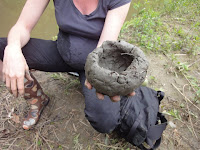Conservation of Fire I - Mud Pots
Long before the human being could produce fire, they could only "steal" it, and then conserve it. This period of learning how to conserve fire before knowing how to make it lasted hundreds of thousands of years, maybe even a million...
Mixing in dried grass helped to keep the mud strong and flexible, and who knows what else got mixed in there along with it (geese and duck crap for sure).
Making Mudpots
Now we'll let these dry for a good while and then the next step will be to fire them in an open fire to get that good, old "baked mud" mentioned by Silo:
We started our conservation of fire workshop this weekend with a trip to the Don River near Old Mill Station. There by the river's edge we dug up mud and proceeded to make little pots that we'll use later to conserve fire. The idea was to make a little mud "oven" with a hole towards the bottom for blowing in air, and a hole up top for the chimney.
Mixing in dried grass helped to keep the mud strong and flexible, and who knows what else got mixed in there along with it (geese and duck crap for sure).
Now we'll let these dry for a good while and then the next step will be to fire them in an open fire to get that good, old "baked mud" mentioned by Silo:
"I think that we should start with that baked mud which is not yet clay, it's the mud of the Popul Vuh, the mud used by the Shapers, the Annunciators, the Grandmother of the Dawn, the Grandmother of the Day, to make the first human being. But they made the first human being and the rains started and so the legs of the man of mud would bend and he would fall. And so they had to make another human being. That's proper to a pre-ceramic civilization; they lacked a temperature high enough to make an interesting human being. That is, they were getting to about 800°C in that historical moment in which the Popul Vuh was written. Then they achieved higher heat and started making things out of ceramic. But that was baked mud, and baked mud works if it is burnished… It can hold water for a while, and then it starts to leak, and finally it falls apart on you. And that's just like in the Popul Vuh. In any case, I believe we could start with baked mud. It's clay that you let dry out well so that it doesn't fall apart, and then you fire it to less than 800° (you can get to 800 or 700°C). It's a mud that all prehistoric civilizations have known: baked mud. It's not ceramic."
- from The Craft of Fire, Silo, The Talk of 'The Stone'
 |
| (mud pot, fallen apart after nearly a year of sitting outside in the elements) |


Comments
Post a Comment